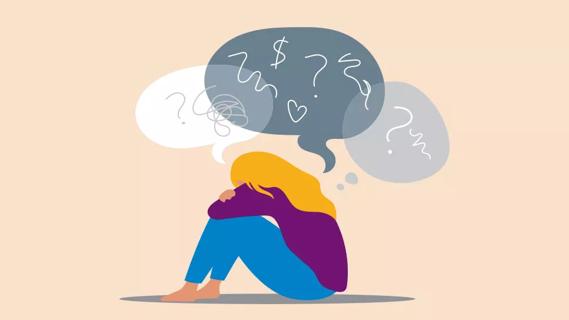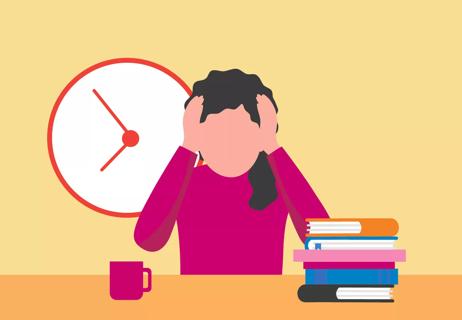Focusing on what you can see, feel, touch and hear can help you feel more present in the moment

Sometimes, our emotions can be overwhelming. Whether it’s feelings of anxiety, stress, fear or depression, these powerful emotions can make us feel untethered.
Advertisement
Cleveland Clinic is a non-profit academic medical center. Advertising on our site helps support our mission. We do not endorse non-Cleveland Clinic products or services. Policy
Your fight-or-flight response may kick in as your brain is trying to convince you that you are unsafe. This can lead you to feel uneasy or even escalate to an anxiety attack or panic attack.
Taking steps to ground yourself in the present can help you reset, says functional medicine specialist Melissa Young, MD. “It’s a form of distraction from those difficult emotions,” she explains.
Dr. Young walks us through the best ways to soothe your anxiety through different grounding techniques.
Grounding techniques are a set of simple strategies that help calm your anxiety by focusing on the here and now. Think of your mind as a tree and your anxiety is a storm blowing your branches in all directions. Grounding techniques are the thing that can keep you rooted and safe, like a tree in the face of strong winds.
And like the wind won’t stop blowing, your anxiety won’t completely go away either. It’s an important part of our nervous system that is activated when you’re in danger. But it doesn’t need to cause you constant distress or physical discomfort.
That’s where grounding techniques come in — a helpful toolkit for taming the storm inside your mind. “They help bring us back into the present moment,” Dr. Young explains.
Advertisement
Grounding techniques can help with:
In general, grounding techniques are broken into three categories: mental, physical and soothing. Think of these as different access points for you to calm down your mind and body.
Mental grounding techniques are mostly based in imagery. By performing certain exercises with your mind, you can distract it from the anxiety.
Think of your “happy place.” What is a place — real or imaginary — that makes you feel safe and calm?
“For instance, if you love the beach, try bringing in all the senses of that space,” Dr. Young suggests. “The feeling of the hot sun on your face or body, hearing the waves lapping on the shore. How does the sand feel under your feet?
“If you’re imagining yourself in your favorite place, you will have less production of those stress hormones,” she says.
An even simpler mental exercise is going back to the basics. When our mind is consumed by anxiety, we’re being pelted with negative thoughts and worst-case scenarios. That’s why Dr. Young recommends focusing on what you know to be true. For example, simply counting to 10 or reciting the alphabet. You can do this silently in your head. If you get to “Z” or “10” and are still feeling tense, try doing it again backward.
Sometimes, when your mind is a mess, it’s good to give yourself a task. Categorizing can be an easy way to refocus your mind away from your worries. Take a couple minutes to categorize a couple items on your desk — maybe it’s by color, size or texture. Maybe you put all the scattered pens around you in one pile and highlighters in another. Refocusing your attention can help you refocus your mind.
Physical grounding techniques focus on how your senses can help you feel present. These exercises mainly focus on what you can see, feel, touch, hear and taste.
Most days, what we’re seeing, hearing or smelling is on autopilot. But focusing in on the world around us with our senses can be a great way to feel more present and at peace.
Dr. Young recommends the 3-3-3 technique, where you focus on three things you can see, hear and touch. Don’t overthink it. In your immediate surroundings, what can you see? A tree outside your window? A book on your shelf? A photo on your desk?
“So, we’re not only searching out an object, but we’re also really looking for the colors, the textures and other details,” she adds.
Repeat this process for touch and smell — whether it’s the flowery scent of someone’s perfume or the soft feeling of your cotton shirt.
Advertisement
Another version of this technique is the 5-4-3-2-1 technique where you list:
Physical exercises can also help you feel more steady. Dr. Young recommends holding onto something tightly — whether it’s your fist, your pen, the edge of your desk or something else nearby. Giving that anxious pressure somewhere to land can make you feel lighter afterward.
“When it comes to physical grounding, clenching your fists tightly or holding onto the back of a chair tightly is at the top of the list,” Dr. Young shares.
If there’s a pool, lake or other body of water accessible to you, dipping your toes in may help you feel more grounded. But you don’t need a whole swimming pool for this practice. Dr. Young says it can also be helpful to run warm or cool water over your hands.
You may be surprised how much good a deep stretch can do. Stretching your body helps you get outside your mind and back into your body. This doesn’t have to be a full yoga session either, although that can absolutely help as well!
Simple stretches include:
Advertisement
Another option is doing some basic yoga poses like:
While breathing is often an unnoticeable thing we do, focusing on each inhale and exhale can make you more in tune with your body.
“It works for physical grounding because you’re noticing the movement of air in and out of your nostrils,” explains Dr. Young. “Or you notice your belly rising and falling when you're breathing in and out deeply.”
Advertisement
You can also try more specific breathing techniques like:
Soothing grounding techniques promote good feelings and help remove negative thoughts that may be consuming your mind. Some of these may overlap with the physical and mental techniques above, says Dr. Young.
If you have a furry friend at home, finding comfort in them can make a huge difference. Not only can this be calming to your senses, but spending time with another living thing you love can help take your mind off stressful thoughts, too.
“Studies have also shown that petting our animals at home does help to actually decrease cortisol, that main stress hormone that’s produced when we’re anxious or stressed,” Dr. Young shares.
When we’re in a state of worry, a kind word can go a long way. A lot of times, we know exactly what we need to hear to feel better. And positive affirmations can give you the words to do it. “Say kind statements to yourself as if you were talking to a good friend or a child,” Dr. Young suggests.
She recommends saying things that will make you feel reassured and safe, like:
Creativity can also play a role in calming your nervous system down. The options here are endless. “Adult coloring books are all the rage right now and they’re fantastic,” Dr. Young says. “Focusing on just coloring and picking your next color keeps you in the moment and distracts you from those emotions.”
Listening to your favorite record or playlist is a great way to self-soothe. Maybe you even create an “emergency kit” playlist with songs that you know will make you feel present when you’re in a state of stress.
“Listening to music is a wonderful way to soothe,” shares Dr. Young. “There are studies that show how music can shift us out of fight or flight and provide calm.”
Not sure what kind of music calms you down? Maybe start with a sound bath.
Dr. Young also highlights the importance of grounding yourself in nature. After all, what’s more grounded than feeling the earth beneath your feet?
“Walking barefoot on the grass or sand if you’re on the beach or submerging yourself in natural bodies of water may have a grounding effect,” Dr. Young says. “I think it’s so easy to do, but we’ve forgotten that connection.”
In simple terms, anxiety is when you become consumed by worries about the future. If you’re feeling anxious, it’s probably because you’re focusing on what will be, what could’ve been or what has passed. Whatever it is, your anxiety is keeping you from the present moment.
When we practice grounding techniques, we move ourselves away from the worries and the “what ifs” and just sit in “the now.”
“It helps bring you back into your body,” says Dr. Young. “I think when people are in pain or very anxious or stressed, they tend to disconnect a little bit from their physical bodies.”
As she explains, grounding techniques allow you to short-circuit that stress response. And you can decide if physical, mental or soothing techniques (or a combination of all three) work best for you.
“It’s more a matter of personal preference. I’m always encouraging people to try different techniques because there’s so many options and, really, some resonate with some people more, and less so with others,” she adds.
When you feel overwhelmed by anxiety, it can be hard to enjoy your day-to-day. But grounding techniques can help distract, soothe and refocus those feelings.
Learn more about our editorial process.
Advertisement

Managing stress can help you sleep more soundly

This fast-acting anxiety medication should never be taken with alcohol, despite what you may see on The White Lotus

Deep breathing, positive mantras and tackling negative thoughts can help get you out of your head and cool down your anxiety

Performance anxiety and stage fright are outsized stress responses that can creep up when you’re put on the spot

A healthy amount of anxiety can keep you safe from harm and motivate you to take action

Although different conditions, they can occur together or cause one another

Stay merry and bright by knowing your triggers and journaling throughout your visit

Breathwork, sleep meditation and avoiding screens can help fight back morning anxiety

The ‘sunshine vitamin’ is found naturally in some fish and is added to other foods

Autism and ADHD often go hand in hand, giving rise to the term AuDHD

The Yuzpe regimen is less effective than other forms of emergency contraceptives, and it’s associated with more side effects